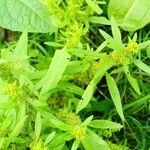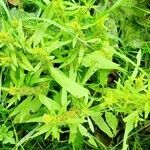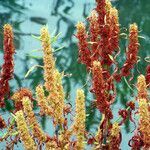Fibrous-rooted, hollow-stemmed annual to 8 dm, often bushy-branched; lvs narrowly lanceolate to oblong-linear, the larger commonly truncate to subcordate at base, the margins often crisped; panicle large and freely branched, many of the verticils subtended by small lvs; pedicels jointed near the base, twice as long as the fr; valves triangular-ovate, 2–3 mm, with 2 or 3 divergent marginal bristles on each side, the free tip triangular; grains 3; 2n=40. Shores, streambanks, and wet ground, avoiding acid soils; widespread in Eurasia, and irregularly in N. and S. Amer. Typical R. maritimus is European. We have 2 vars. Var. fueginus (Phil.) Dusén, widespread in both N. and S. Amer., has narrowly lanceolate grains, 0.3–0.4 mm wide and tapering to the summit, and the valves have relatively long marginal bristles, to ca 2.5 mm. Var. persicarioides (L.) R. S. Mitch., occurring in coastal marsh areas from L.I. and Mass. to Que., and from n. Calif. to B.C., has broader, ellipsoid grains, 0.4–0.6 mm wide and rounded to the summit, nearly concealing the body of the valve, which has shorter marginal bristles, 0.5–1.5 mm. (R. persicarioides, but the name often misapplied to var. fueginus)
Herbs annual, rarely biennial, especially in S regions. Stems erect, 15-60 cm tall, branched below middle, grooved, glabrous or weakly shortly papillose. Lower leaves: petiole 1-2.5 cm; leaf blade lanceolate or lanceolate-oblong, 4-15(-20) × 1-3(-4) cm, both surfaces glabrous or shortly papillose below, base narrowly cuneate, margin entire and smooth, or occasionally slightly undulate, apex acute, cauline leaves shortly petiolate or nearly sessile, smaller than basal ones; ocrea fugacious, membranous. Inflorescence paniculate. Flowers bisexual. Pedicel filiform, articulate at base or slightly above base, articulation indistinctly swollen. Outer tepals elliptic, ca. 2 mm; inner tepals enlarged in fruit; valves narrowly triangular-ovate, 2.5-3.5 × 0.8-1.5 mm wide, all valves with tubercles, base truncate, each margin with 2 or 3(or 4) teeth, apex acute; teeth 2.5-3 mm, narrow; tubercles oblong, ca. 1.5 mm. Achenes yellow-brown, shiny, ellipsoid, sharply trigonous, 1.5-2 mm. Fl. May-Jun, fr. Jun-Jul. 2n = 40.
An erect herb. It has a rootstock that lasts from year to year. It grows 25-70 cm tall. The leaves are narrowly oval and heart shaped at the base. The lower leaves have long stalks and upper leaves are small and have short stalks. The flowers are in rings. The fruit are small brown nutlets.








